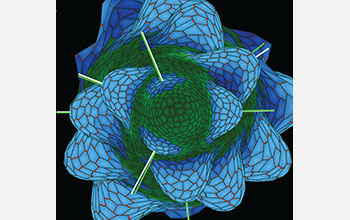Multimedia Gallery
Asymmetry in plants
Previously overlooked asymmetry has been found in Arabidopsis and tomato leaves.
More about this image
Research shows that the spiral pattern of leaf formation from the point of growth affects the developing leaf's exposure to the plant hormone auxin. This exposure leads to measurable left-right asymmetry in leaf development in species previously assumed to have symmetric leaves. The front of a leaf is different from the back of a leaf, and the tip is different from the base. However, a leaf from a tomato or an Arabidopsis plant superficially appears to be bilaterally symmetrical, or the same on the left and right sides. Don't let its appearance fool you; there is an underlying asymmetry between the left and right sides of such leaves -- it just took a while for scientists to discover it.
This research was supported in part by the National Science Foundation (grant IOS 08-20854).
To learn more about this research, see the Science Daily news story Is your leaf left-handed?. (Date image taken: June 2012; date originally posted to NSF Multimedia Gallery: Dec. 26, 2017)
Credit: American Society of Plant Biologists
Images and other media in the National Science Foundation Multimedia Gallery are available for use in print and electronic material by NSF employees, members of the media, university staff, teachers and the general public. All media in the gallery are intended for personal, educational and nonprofit/non-commercial use only.
Images credited to the National Science Foundation, a federal agency, are in the public domain. The images were created by employees of the United States Government as part of their official duties or prepared by contractors as "works for hire" for NSF. You may freely use NSF-credited images and, at your discretion, credit NSF with a "Courtesy: National Science Foundation" notation.
Additional information about general usage can be found in Conditions.
Also Available:
Download the high-resolution JPG version of the image. (1.5 MB)
Use your mouse to right-click (Mac users may need to Ctrl-click) the link above and choose the option that will save the file or target to your computer.



